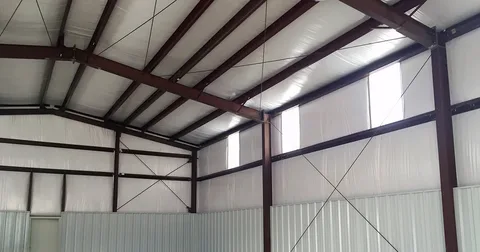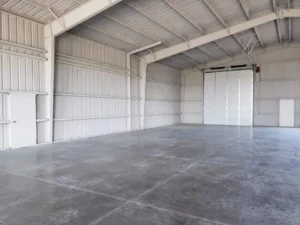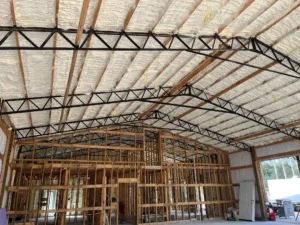Proper insulation is crucial for any building, but especially for metal buildings, which are more susceptible to temperature fluctuations and energy inefficiency due to the properties of metal. Insulating a metal building protects it from extreme weather conditions, improves energy efficiency, and ensures a comfortable environment. This guide will discuss why insulation is essential for metal buildings and how to make informed decisions when choosing the right insulation materials.
Why Metal Buildings Need Proper Insulation
Metal buildings are highly susceptible to heat transfer, which can result in higher heating and cooling costs. Proper insulation helps mitigate these effects by reducing heat loss in the winter and preventing excessive heat gain in the summer. Additionally, insulation helps with condensation control, soundproofing, and overall structural integrity.
Key Benefits of Proper Insulation for Metal Buildings:
- Energy Efficiency: Reduces heating and cooling costs by maintaining consistent indoor temperatures.
- Condensation Prevention: Helps control moisture build-up that can cause rust and mold.
- Comfort: Keeps the interior temperature stable, improving comfort year-round.
- Noise Reduction: Insulation can minimize sound transmission, creating a quieter environment inside the building.
Types of Insulation for Metal Buildings
Selecting the right type of insulation for a metal building depends on the climate, building usage, and budget. Below are the most common types of insulation materials used for metal buildings:
Fiberglass Insulation
Fiberglass is one of the most common insulation materials for metal buildings due to its affordability and ease of installation. It is available in batts, rolls, and loose-fill forms.
Spray Foam Insulation
Spray foam is known for its superior thermal insulation properties and ability to expand upon application, filling gaps and cracks in the building’s structure. It provides excellent air sealing and moisture control.
Reflective or Radiant Barrier Insulation
Radiant barrier insulation works by reflecting heat away from the building. It is particularly effective in hot climates as it helps keep the building cool by reflecting radiant heat.
Rigid Foam Board Insulation
Rigid foam boards are highly effective at providing thermal insulation in metal buildings. They are moisture resistant and provide excellent thermal resistance (R-value).
Mineral Wool Insulation
Mineral wool is an effective choice for metal buildings that require both thermal and sound insulation. It is made from natural or recycled materials and offers high fire resistance.
Comparison of Insulation Types
| Insulation Type | Thermal Resistance (R-Value) | Moisture Resistance | Ease of Installation | Cost | Best Use Case |
| Fiberglass | Moderate (R-3 to R-4) | Low | Easy | Low | Budget-conscious installations |
| Spray Foam | High (R-6 to R-7) | High | Moderate | High | Energy-efficient, air-tight buildings |
| Reflective Barrier | Low (R-1 to R-2) | Moderate | Easy | Moderate | Hot climates, reflective heat control |
| Rigid Foam Board | High (R-5 to R-6) | High | Moderate | High | Cold climates, thermal protection |
| Mineral Wool | Moderate (R-3 to R-4) | Moderate | Moderate | Moderate | Fire-resistant applications |
Things to Consider Before Making a Decision
When selecting insulation for your metal building, several factors must be considered:
Climate
The climate in which your building is located significantly impacts the insulation material you should choose. In colder climates, high R-value materials like spray foam or rigid foam boards are recommended. In hotter climates, reflective barriers may be more suitable.
Building Use
The function of your metal building will also influence your insulation choice. For instance, a warehouse may only need basic thermal insulation, while a manufacturing plant may need soundproofing and superior moisture control.
Budget
Different insulation materials come with varying price tags. While spray foam provides excellent performance, it may come at a higher cost compared to fiberglass. Weighing the long-term energy savings against the initial cost is essential for making an informed decision.
Installation
Installation complexity varies by insulation type. Spray foam, for example, requires professional insulation installation, while fiberglass can be installed by the building owner. Consider the cost and time of installation when making your decision.
Long-Term Maintenance
Some insulation types require more maintenance than others. For example, fiberglass insulation can deteriorate over time if exposed to moisture, whereas spray foam offers long-lasting protection without significant upkeep.
Technical Specifications of Insulation Materials
| Material Type | R-Value per Inch | Moisture Resistance | Fire Resistance | Noise Reduction | Common Thickness | Installation Method |
| Fiberglass Batts | R-3 to R-4 | Low | Moderate | Low | 3-6 inches | Staple or fit in place |
| Spray Foam (Closed-Cell) | R-6 to R-7 | High | High | Moderate | 2-4 inches | Spray application |
| Reflective Barrier | R-1 to R-2 | Moderate | Low | Low | 1-2 inches | Staple or staple-free |
| Rigid Foam Boards | R-5 to R-6 | High | Moderate | Low | 1-2 inches | Mechanical fasteners |
| Mineral Wool | R-3 to R-4 | Moderate | High | High | 3-6 inches | Staple or fit in place |
Common Questions
What is the best insulation for a metal building in a cold climate?
In cold climates, spray foam or rigid foam board insulation are ideal due to their high R-values, which help retain heat and prevent energy loss.
How do I control condensation in a metal building?
To control condensation, ensure proper ventilation and consider insulation materials like spray foam, which acts as both a thermal barrier and moisture sealant.
Can I install insulation myself in a metal building?
Some insulation materials, like fiberglass batts or reflective barriers, can be installed by the building owner. However, spray foam insulation typically requires professional installation due to its complexity.
Is insulation for a metal building worth the investment?
Yes, insulation significantly reduces energy costs and protects your building from moisture, improving the overall durability and comfort of the structure.
Make the Right Decision
Choosing the right insulation for your metal building is essential for long-term energy savings and comfort. Consider your climate, building use, budget, and the long-term benefits of various insulation materials before making a decision. If you’re unsure, consulting with a professional can help ensure you select the best option for your needs.
FAQ
What type of insulation is best for a metal roof?
Spray foam insulation is highly recommended for metal roofs due to its ability to expand and seal gaps, offering superior thermal and moisture protection.
How long does spray foam insulation last?
When installed correctly, spray foam insulation can last for the lifetime of the building, offering durable thermal and moisture protection.
Do I need vapor barriers with insulation in a metal building?
A vapor barrier may be necessary, especially in high-moisture areas, to prevent condensation from accumulating within the insulation.
How does insulation impact the overall cost of a metal building?
While insulation adds to the upfront cost, it can result in significant energy savings over time, making it a cost-effective investment.
Can I insulate my metal building after construction?
Yes, insulation can be added to a metal building after construction, though it is generally easier and more effective to install during the building process.











